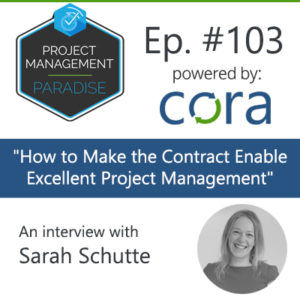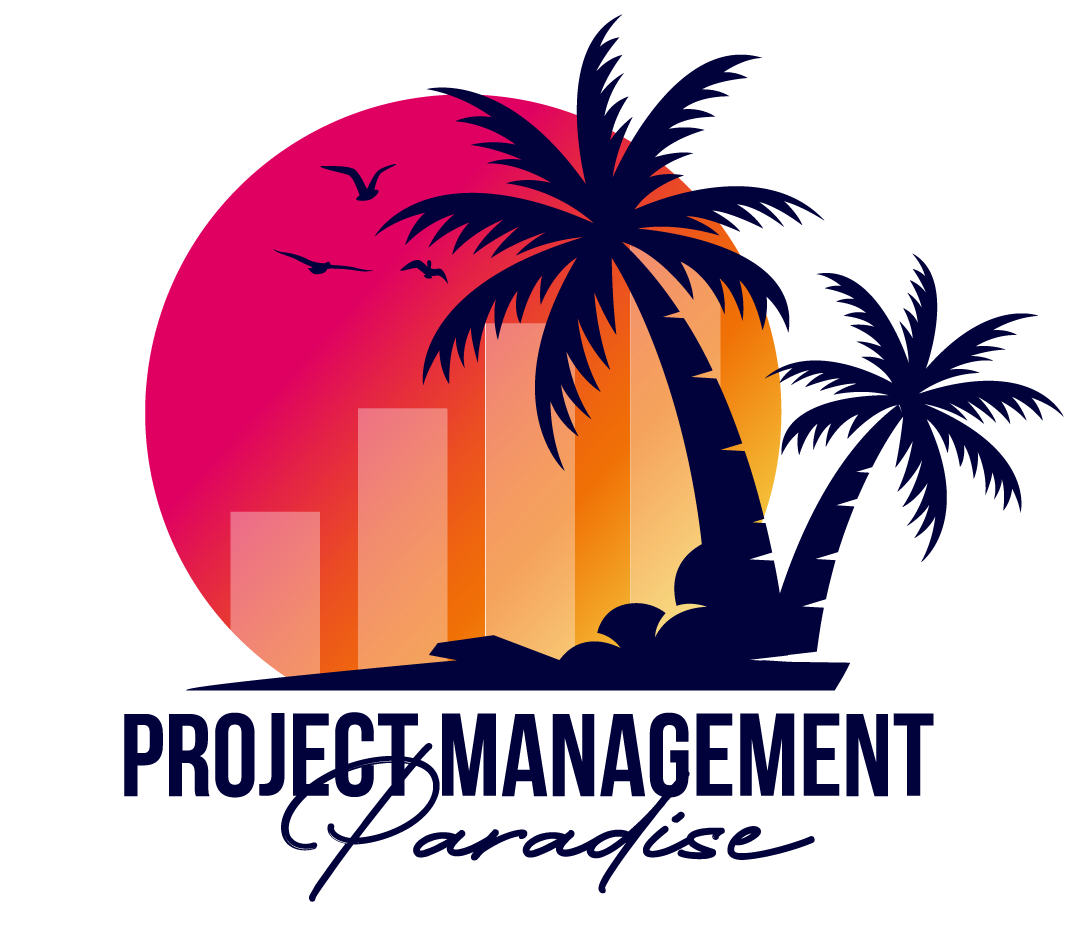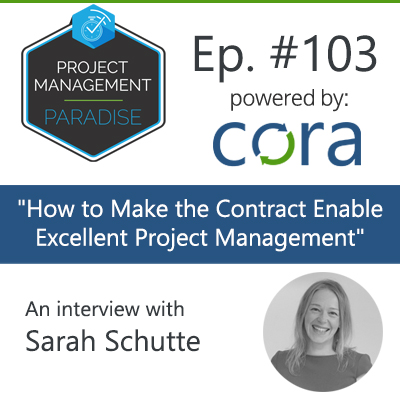In this episode we discuss contract management in Project Management with Sarah Schutte a Solicitor-Advocate, and director of Schutte Consulting, based in London.
Sarah has years of experience with legal matters in the construction and engineering fields with organizations, large and small.
This episode is sponsored by Cora Systems: Powering best-practice enterprise PPM is over 50 countries. Find out more at corasystems.com
Subscribe to Project Management Paradise via one of the links above or on the right and you’ll automatically receive new episodes directly to your device.
Transcript from Episode 103: “Contract Management in Project Management” with Sarah Schutte
Could you tell us a little bit about your background and how you ended up working in the PM space?
 Well, I am a lawyer in the construction and engineering projects field. I qualified in 2001, here in London. I work in a lot of construction and engineering projects as a junior lawyer in the city, from commercial and development projects, hotel ledgers, offices, buying and selling property portfolios and a lot of work in the infrastructure for a public sector clients. I moved to in-house, to the position in the London Underground and Transport for London in 2006 and that was much more active, much more hands-on, I was really a part of the project team, delivering very large caterpillar investment projects, new stations for London Underground.
Well, I am a lawyer in the construction and engineering projects field. I qualified in 2001, here in London. I work in a lot of construction and engineering projects as a junior lawyer in the city, from commercial and development projects, hotel ledgers, offices, buying and selling property portfolios and a lot of work in the infrastructure for a public sector clients. I moved to in-house, to the position in the London Underground and Transport for London in 2006 and that was much more active, much more hands-on, I was really a part of the project team, delivering very large caterpillar investment projects, new stations for London Underground.
And then when the legal team of the London Underground was merged in with the more general legal team of Transport for London, I acquired some additional responsibility which included like field offices and looking how the roads are maintained under the highways. I really, really love that move It was the right place for me to be, I am a very active and hands-on person, and I love being in the project team.
I stayed there for many years and then I moved to WSP, a very large, multidisciplinary engineering company and worked with them between 2014 to very early 2015, working on some of the projects in the UK and also abroad. At that point, I realized that I was really interested in how business is working and I wanted to step into the world of independent consultancy. That’s a huge step. There are pros and cons that you have to go through and work out if that is the right step for you. I was convinced it was and I’m still convinced it is. We just celebrated our 6th birthday here at the Consultancy and I’m really proud of what we achieved in that time.
Being in an independent consultant to the industry has been brilliant. I have a wonderful client base that I work with, a lot of challenging projects and what we are really trying to do is to bring the motto of the company to live, which is “Making the law work for construction and engineering industry”. That is the basis of which everything we do since we were founded. Yes, it is about the goal. Yes, it is about the framework, contracts and how projects come together but making it work in a way which is useful to people, which is usable and user-friendly.
And also to help people to work out their way through a minefield of different sorts of risks which come before projects, of course, unexpectedly. I was really trying to give the clients the foresight they can have in the construction project and what kind of thing to take into account. I have been there for 5 years or so and I am really thrilled with what we were able to achieve. The future looks really exciting, so I am really happy I am able to showcase that as well.
From your experience, when it comes to contracts, what is the biggest lesson you have learned about risk management?
I think probably over the years what I have noticed is that, and I think this is inevitable across the project management industry generally is the reception of how the risk is dealt with. Risk is a growing discipline like project management is a growing discipline. It has always been around and the people have always dealt with it, perhaps unknowingly, it hasn’t been like that in a systematic and logical fashion, going now in the national standards which help us with identifying, assessing it and managing it in traditional three steps of how do we deal with risks.
To me, the biggest lesson I have learned is that with that experience comes a bit of danger of complacency. I think it is inevitable as we get more experience we tend to become more comfortable with what we are dealing with and I think the way to combat that is to make sure that we, as teams and leaders of project teams, that we engage very early in that exercise of risk. And the way that you do that is to invite a wide range of people, the multi-disciplines we need to run that project, to contribute to that exercise. I include in that project team the legal support, governance people and contracts people.
All of those have something which is different to offer, it’s not technical risk, it’s not about a particular project risk that those who are technically minded and technical expertise works out for us. Our approach to risk is more about legal risk. How this project is going to be perceived? How is it going to be audited? What is the public perception? I think those disciplines, it would be great to have those consulted more often and widely. At a point you can start shape properly what the project is going to look like and then get on to the more exciting bit – the delivery, getting this project, building this thing and having something people can see, use, feel and benefit from. And that bit is the exciting step, compared to boring preparation stuff which is just as important but not as interesting and certainly less exciting. But it really, really helps to make sure that the delivery side of things is more smooth and easier. For me, that’s a risk in a contract in a nutshell.
Do you have a stock set of risk impact areas or does it depend on the project?
I think most of the project teams that I have work with having some sort of stocks that. It’s great to have a template to start with, in the standard form of contract. The danger really is you take what you have used before and don’t really critically analyse is this stock set is right for this project and have we missed anything, do we need to add anything, is anything irrelevant and we can cross it off the list. We often use a template because people don’t have time to think straight and the consultation I suggest doesn’t get done.
That’s when you start the fragility and putting the contract in the structure together. It is great to have stock, it is great to have a template but I think there is an active exercise which is really, really valuable to do and I think it will bring benefits later on. Because it is like going to a tailor when you take a jacket or a suit and they give it the nips and the tucks, and the extended sleeves and that sort of things you need to have for that particular item. You don’t just pull it off the shelf and put it on and walk out of the shop. It is the same with the project and the contracts as it is a great opportunity and this is something which is getting that investment on time and early on. And a risk on the contract is particularly adept to benefiting from that early.
When it comes to early engagement, how do your planning and scheduling come in?
Early engagement I think is the key as we talked about previously. Project management as a profession is a growing discipline where identifying how the world is working that we have a need for strong project managers, that the world is becoming projectized to some extent and that we need a specialist to help us deliver a particular project that individuals and businesses want to do.
For me, I love that and everyone who has heard me on the conferences and other podcasts like this know that I mentioned the skills demanded of the project manager are incredibly difficult to do, it is a really difficult job to do well and it requires support from very different functions. When I talk about project controls being almost a sub-branch of the project management industry. It’s a highly specialized part of what the project management as a function needs to achieve. I find it fascinating, another analogy I used recently in Dublin when I was at the PMIS summit is the hub and the wheel.
The hub is the central part of keeping the wheel turning, being of course project progressing and going and delivering. And project control is one of those stakes that keep the wheel’s shape so it can continue to roll, to go forward and not go flat or backward or fall over. It is increasingly important that project management as a function isn’t just planning, it isn’t just putting a schedule together or a program and saying ”Look what happened last month” We definitely need that to be done, we definitely need the ability to look back and see what happened, why did this happened and have we learned something. But we need project control as a function to achieve what you really want it to achieve, you have to look at it as a whole.
One of the demands that I make on my projects, including those that have disputes attached to them, is often and a most important bit about the forensic dig-around that I do is – what can we see coming up from this project, how we might deal with it, what happened before, you have things coming from the sides of the project and you need to have a visibility of all the stuff that comes to the project and then we come to what people talk about the most which is how much will cost and how long is this take.
And the third one is the quality which people quite often forget. The real question sits behind those three things is the question of the control, what we have to drive that delivery so that we have the real answer to those two first questions, instead of jumping all those stages and then look back on what has been happening. Sometimes it works and sometimes it doesn’t. For me, it is not quite as systematic as it should be, it could be a lot more disciplined, and the application of those skills would bring a quicker turnaround.
So, it is really good to have that, that look back where teams go “Okay, we have got a project control and I’m going to have a session with you on your own. This is your time, dedicated to me listening to you and giving you the voice you need.” in order for them to support the project management functions as a whole. Project control is really important and not at all about looking at the program and coming up with – this is going to happen next.
What are the keys to managing these conflicts and disputes because you have different types of people in your team, and how do we avoid them in the first place?
I have to say I think that conflicts are inevitable to some extent and that is not a negative view at all. I think it’s realistic because human beings don’t always get on. I think that if we approach projects from a viewpoint that we won’t have any disputes on this project, we are not going to log in any claims, I think you are hiding behind nothing. It will simply happen, it happens on projects. You can have the best risk managers and the best project control foresight people in the world – it will happen.
I think it is more important to accept that this stuff is going to happen. But what are we going to do about it? Let’s talk about that early on, when we put the contract together, let’s talk about it, what are we going to do when something happens. I think the key to those conflict resolution and dispute avoidance is every time slightly different. I like to call it problem-solving because it is slightly softer. I think it is also more realistic and it’s wider.
People don’t like talking about the disputes but if you talk about problem-solving “Okay, something happened, we need to sit down and talk about it.” That is much more palatable to people. And they are less likely to stick their heads in the sand. If you say “We now have a dispute and we need this procedure” and the rest of the people go “Woah. We are not in that category.” So, let’s accept that this is going to happen and that humans don’t always get on. And let’s talk about problem-solving.
The key to problem-solving is, no doubt, solid contract management from the beginning, coupled with communication’s framework – try it, test it and see what works. And the contract management bit includes using whatever tools you need to put into the contract and to use them in a positive and a proactive way. Yes, we have a procedure for a type of contract that is used widely. I think that a system that is called the Early Warning System is a great process. We had different projects that have different approaches to that process and I have contract managers coming to me saying “Of course, we’re not going to be using that too much” and I say ”No, let’s read it together. It is just a flag.” That is all that it’s doing.
Show Notes:
Find out more about Schutte Consulting at schutteconsulting.co.uk



